Articles
- Page Path
- HOME > J Korean Acad Nurs > Volume 45(2); 2015 > Article
-
Original Article
- Gender Difference in Osteoporosis Prevalence, Awareness and Treatment: Based on the Korea National Health and Nutrition Examination Survey 2008~2011
- Yunmi Kim, Jung Hwan Kim, Dong Sook Cho
-
Journal of Korean Academy of Nursing 2015;45(2):293-305.
DOI: https://doi.org/10.4040/jkan.2015.45.2.293
Published online: April 30, 2015
1College of Nursing, Eulji University, Seongnam, Korea.
2Department of Family Medicine, Eulji Hospital, Seoul, Korea.
- Address reprint requests to: Cho, Dong Sook. College of Nursing, Eulji University, 553 Sanseong-daero, Sujeong-gu, Seongnam 461-832, Korea. Tel: +82-31-740-7157, Fax: +82-31-740-7359, E-mail: chds@eulji.ac.kr
© 2015 Korean Society of Nursing Science
This is an Open Access article distributed under the terms of the Creative Commons Attribution NoDerivs License. (http://creativecommons.org/licenses/by-nd/4.0/) If the original work is properly cited and retained without any modification or reproduction, it can be used and re-distributed in any format and medium.
Abstract
-
Purpose
- The aim of the study was to assess and identify gender differences in factors associated with prevalence, awareness, and treatment of osteoporosis.
-
Methods
- Data for 3,071 men and 3,635 women (age≥ 50) from the Korea National Health and Nutrition Examination Survey 2008~2011 were included. Osteoporosis was defined by World Health Organization T-score criteria. Impact factors and odds ratios were analysed by gender using multivariate logistic regression.
-
Results
- Osteoporosis prevalence rates were 7.0% in men and 40.1% in women. Osteopenia rates were 45.5% and 46.0% respectively. Among respondents with osteoporosis, 7.6% men and 37.8% women were aware of their diagnosis. Also 5.7% men with osteoporosis and 22.8% women were treated. Higher prevalence was found among respondents who were older, at lower socioeconomic levels, with lower body mass index and shorter height in both genders, and among women with fracture history, and non-hormonal replacement therapy. Awareness and treatment rates for the risk groups were similar compared to the low risk controls for both genders. Fracture history increased awareness and treatment rates independently for both genders. Women with perceived poor health status and health screening had increased awareness and treatment rates, but not men.
-
Conclusion
- Results indicate that postmenopausal women have a higher prevalence of osteoporosis than men and awareness and treatment rates were higher than for men. Despite gender difference in prevalence, osteoporosis was underdiagnosed and undertreated for both genders. Specialized public education and routine health screenings according to gender could be effective strategies to increase osteoporosis awareness and treatment.
- 1. Assessment of fracture risk and its application to screening for postmenopausal osteoporosis Report of a WHO Study Group. World Health Organ Tech Rep Ser. 1994;843:1–129.PubMed
- 2. NIH Consensus Development Panel on Osteoporosis Prevention, Diagnosis, and Therapy. Osteoporosis prevention, diagnosis, and therapy. JAMA. 2001;285(6):785–795.ArticlePubMed
- 3. WHO Scientific Group on the Burden of Musculoskeletal Conditions at the Start of the New Millennium. The burden of musculoskeletal conditions at the start of the new millennium. World Health Organ Tech Rep Ser. 2003;919:i–x.PubMed
- 4. Oh HJ. Development of guideline for life cycle osteoporosis health care. Osong: Korea Centers for Disease Control and Prevention; 2011.
- 5. Cawthon PM. Gender differences in osteoporosis and fractures. Clin Orthop Relat Res. 2011;469(7):1900–1905. ArticlePubMedPMC
- 6. Lips P, van Schoor NM. Quality of life in patients with osteoporosis. Osteoporos Int. 2005;16(5):447–455. ArticlePubMedPDF
- 7. Health Insurance Review & Assessment Service. A dramatic increase of elderly osteoporotic patients [Internet]. Seoul, Author. 2013;cited 2013 February 22. Available from: http://www.hira.or.kr/dummy.do?pgmid=HIRAA02004100000&cmsurl=/cms/notice/02/1316013_13390.html&subject
- 8. Alswat K, Adler SM. Gender differences in osteoporosis screening: Retrospective analysis. Arch Osteoporos. 2012;7(1-2):311–313. ArticlePubMedPDF
- 9. Park EJ, Joo IW, Jang MJ, Kim YT, Oh K, Oh HJ. Prevalence of osteoporosis in the Korean population based on Korea National Health and Nutrition Examination Survey (KNHANES), 2008-2011. Yonsei Med J. 2014;55(4):1049–1057. ArticlePubMedPMC
- 10. Lee SR, Kim SR, Chung KH, Ko DO, Cho SH, Ha YC, et al. Mortality and activity after hip fracture: A prospective study. J Korean Orthop Assoc. 2005;40(4):423–427.ArticlePDF
- 11. Hawkes WG, Wehren L, Orwig D, Hebel JR, Magaziner J. Gender differences in functioning after hip fracture. J Gerontol Ser A Biol Sci Med Sci. 2006;61(5):495–499.Article
- 12. Lee K. Evidence-based management for osteoporosis. J Korean Med Assoc. 2011;54(3):294–302. Article
- 13. Kweon S, Kim Y, Jang MJ, Kim Y, Kim K, Choi S, et al. Data resource profile: The Korea National Health and Nutrition Examination Survey (KNHANES). Int J Epidemiol. 2014;43(1):69–77. ArticlePubMedPMC
- 14. Kim KH, Lee K, Ko YJ, Kim SJ, Oh SI, Durrance DY, et al. Prevalence, awareness, and treatment of osteoporosis among Korean women: The fourth Korea National Health and Nutrition Examination Survey. Bone. 2012;50(5):1039–1047. ArticlePubMed
- 15. Kim JY, Kim SH, Cho YJ. Socioeconomic status in association with metabolic syndrome and coronary heart disease risk. Korean J Fam Med. 2013;34(2):131–138. ArticlePubMedPMC
- 16. International Physical Activity Questionnaire. Guidelines for data processing and analysis of the International Physical Activity Questionnaire (IPAQ): Short and long forms [Internet]. Huddinge, SE, Author. 2005;cited 2014 June 20. Available from: https://sites.google.com/site/theipaq/scoring-protocol/scoring_protocol.pdf
- 17. The Korean Nutrition Society. Dietary reference intakes for Koreans. Seoul: Author; 2010.
- 18. Korea Centers for Disease Control and Prevention. Korea National Health and Nutrition Examination Survey and Korean Youth Risk Behavior Survey. In: Paper presented at: The 5th Data Analysis Conference. 2014 July 2; aT Center Conference Room (L). Seoul.
- 19. Lee J, Lee S, Jang S, Ryu OH. Age-related changes in the prevalence of osteoporosis according to gender and skeletal site: The Korea National Health and Nutrition Examination Survey 2008-2010. Endocrinol Metab. 2013;28(3):180–191. Article
- 20. Cosman F, de Beur SJ, LeBoff MS, Lewiecki EM, Tanner B, Randall S, et al. Clinician's guide to prevention and treatment of osteoporosis. Osteoporos Int. 2014;25(10):2359–2381. ArticlePubMedPMCPDF
- 21. Kao CH, Chen CC, Wang SJ. Normal data for lumbar spine bone mineral content in healthy elderly Chinese: Influences of sex, age, obesity and ethnicity. Nucl Med Commun. 1994;15(11):916–920.PubMed
- 22. Russell-Aulet M, Wang J, Thornton JC, Colt EW, Pierson RN, Jr . Bone mineral density and mass in a cross-sectional study of white and Asian women. J Bone Miner Res. 1993;8(5):575–582. ArticlePubMedPDF
- 23. Haaland DA, Cohen DR, Kennedy CC, Khalidi NA, Adachi JD, Papaioannou A. Closing the osteoporosis care gap: Increased osteoporosis awareness among geriatrics and rehabilitation teams. BMC Geriatr. 2009;9:28ArticlePubMedPMCPDF
- 24. Seo SY, Lee JS. Influence of knowledge and subjective health status on health promoting behavior about osteoporosis in industrial workers. J Muscle Joint Health. 2012;19(3):340–349. Article
- 25. Jennings LA, Auerbach AD, Maselli J, Pekow PS, Lindenauer PK, Lee SJ. Missed opportunities for osteoporosis treatment in patients hospitalized for hip fracture. J Am Geriatr Soc. 2010;58(4):650–657. ArticlePubMedPMC
- 26. Kiebzak GM, Beinart GA, Perser K, Ambrose CG, Siff SJ, Heggeness MH. Undertreatment of osteoporosis in men with hip fracture. Arch Intern Med. 2002;162(19):2217–2222.ArticlePubMed
- 27. Majumdar SR, Beaupre LA, Harley CH, Hanley DA, Lier DA, Juby AG, et al. Use of a case manager to improve osteoporosis treatment after hip fracture: Results of a randomized controlled trial. Arch Intern Med. 2007;167(19):2110–2115. ArticlePubMed
- 28. Song MS, Yoo YK, Choi CH, Kim NC. Effects of Nordic walking on body composition, muscle strength, and lipid profile in elderly women. Asian Nurs Res. 2013;7(1):1–7. Article
- 29. Yoo YW, Lee EN. The influencing factors of the compliance level with therapeutic regimen after the bone mineral densitometry. J Korean Acad Nurs. 2004;34(1):63–71.ArticlePDF
- 30. Lee HY, Kim SY. The effect of education for prevention of osteoporosis patients with bone fracture. J Korean Acad Nurs. 2001;31(2):194–205.ArticlePDF
REFERENCES
Odds ratios for Osteoporosis Prevalence, Awareness and Treatment by Gender
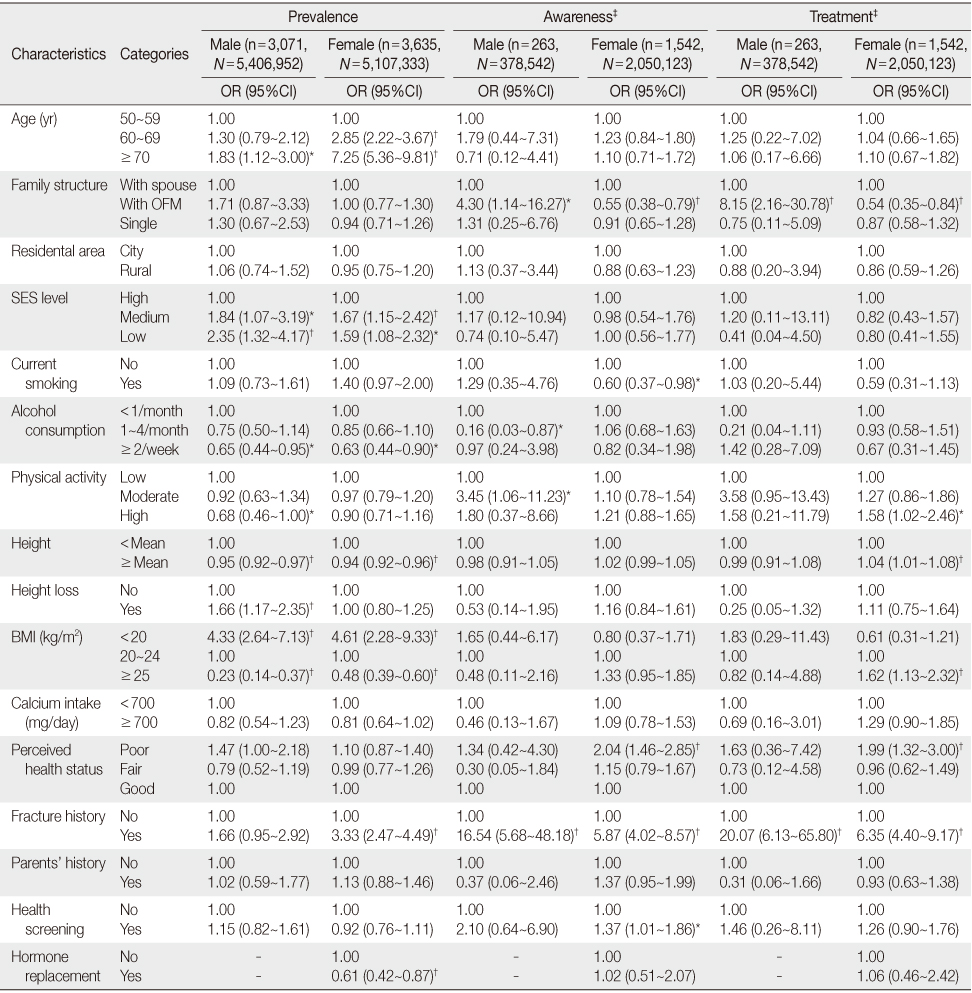
OR=Odds ratio; CI=Confidence interval; OFM=Other family members; SES=Socioeconomic status; BMI=Body mass index; n=Unweighted sample size; N=weighted sample size; All data were weighted to the residential population of Korea; *p<.05; †p<.001; ‡Among persons with lumbar spine or femoral neck T-score≤ -2.5, or taking anti-osteoporotic medications.
Figure & Data
REFERENCES
Citations

- Evaluation of radiation dose to Korean population by general radiography
Hyung Woo Nam, Min Woo Kwak, Shin Dong Lee, Ju Young Kim, Kwang Pyo Kim
Nuclear Engineering and Technology.2025; 57(4): 103286. CrossRef - Effects of Gender-Specific Differences on Anthropometric Measurements and Blood Lipid Levels in Fatty Liver Grades
Youl-Hun Seoung
Journal of Radiological Science and Technology.2025; 48(1): 55. CrossRef - Exposure and health effects follow-up study of residents near a former smelter site
Young-Hun Kim, Da-Som Lee, Jung-Eum Lee, Heon Kim, Yong-Dae Kim, Young-Seoub Hong, Jung-Duck Park, Byung-Sun Choi
Toxicological Research.2025; 41(5): 523. CrossRef - A Study of Prevalence and Awareness of Low Bone Density of Female Utilizing Dental Panoramic Radiographs
Sung Jin Kim, In-Ja Song, Eun Joo Lee, Suk-Ja Yoon
The Korean Journal of Oral and Maxillofacial Pathology.2024; 48(3): 23. CrossRef - A Study of the Relationship Between Kidneys, Bones, and Teeth in Eastern-Western Medicine
Eun Bi Lee, Sang Yun Han
Journal of Physiology & Pathology in Korean Medicine.2024; 38(5): 187. CrossRef - Association between dietary intake of α-tocopherol and cadmium related osteoporosis in population ≥ 50 years
Renjia Li, Hai Qu, Jinwei Xu, Huiqin Yang, Jinyao Chen, Lishi Zhang, Jiuming Yan
Journal of Bone and Mineral Metabolism.2023; 41(4): 501. CrossRef - Tenofovir disoproxil fumarate versus tenofovir alafenamide on risk of osteoporotic fracture in patients with chronic hepatitis B: A nationwide claims study in South Korea
Eunju Kim, Hyun Woong Lee, Soon Sun Kim, Eileen Yoon, Eun Sun Jang, Jong‐In Chang, Young Youn Cho, Gi Hyeon Seo, Hyung Joon Kim
Alimentary Pharmacology & Therapeutics.2023; 58(11-12): 1185. CrossRef - Effect of
Spatholobus Suberectus Extract (SSE) on RANKL-treated RAW264.7 and LPS-induced Bone Loss
Dae Joong Lee, Jong Hyun Hwang, Do Hwi Park, Ki Sung Kang, Chan Yong Jeon, Gwi Seo Hwang
The Journal of Internal Korean Medicine.2022; 43(6): 1134. CrossRef - Efficient estimators with categorical ranked set samples: estimation procedures for osteoporosis
Armin Hatefi, Amirhossein Alvandi
Journal of Applied Statistics.2022; 49(4): 803. CrossRef - Up-to-Date Knowledge on Osteoporosis Treatment Selection in Postmenopausal Women
Hye Gyeong Jeong, Min Kyung Kim, Hee Jeung Lim, Seul Ki Kim
Journal of Menopausal Medicine.2022; 28(3): 85. CrossRef - Association of Dietary Total Antioxidant Capacity with Bone Mass and Osteoporosis Risk in Korean Women: Analysis of the Korea National Health and Nutrition Examination Survey 2008–2011
Donghyun Kim, Anna Han, Yongsoon Park
Nutrients.2021; 13(4): 1149. CrossRef - Analysis of the relationship between periodontitis and osteoporosis/fractures: a cross-sectional study
Seok-Jin Hong, Byoung-Eun Yang, Dae-Myoung Yoo, Sung-Jae Kim, Hyo-Geun Choi, Soo-Hwan Byun
BMC Oral Health.2021;[Epub] CrossRef - Effect of Dosing Interval on Compliance of Osteoporosis Patients on Bisphosphonate Therapy: Observational Study Using Nationwide Insurance Claims Data
Hyunil Lee, Sangcheol Lee, Dokyung Kim, Weonmin Cho, Sungtan Cho, Siyeong Yoon, Soonchul Lee
Journal of Clinical Medicine.2021; 10(19): 4350. CrossRef - Effects of a health-belief-model-based osteoporosis- and fall-prevention program on women at early old age
Sukhee Ahn, Jiwon Oh
Applied Nursing Research.2021; 59: 151430. CrossRef - Analyses of the relationship between hyperuricemia and osteoporosis
Jung Woo Lee, Bong Cheol Kwon, Hyo Geun Choi
Scientific Reports.2021;[Epub] CrossRef - Analysis of Anthropometric and Behavioral Factors of Korean Female Adolescents According to Age of Menarche: 2013~2017 Korea National Health and Nutrition Examination Survey
Eun–Joo Jeong, Bok-Mi Jung
The Korean Journal of Community Living Science.2020; 31(3): 393. CrossRef - What are the illnesses associated with frailty in community-dwelling older adults: the Korean Frailty and Aging Cohort Study
Sunyoung Kim, Hee-Won Jung, Chang Won Won
The Korean Journal of Internal Medicine.2020; 35(4): 1004. CrossRef - Factors Influencing on Health-Related Quality of Life among Men Osteoporosis Patients over 50 Years
Ji Young Kim, Youngran Yang
Korean Journal of Adult Nursing.2020; 32(2): 145. CrossRef - Bone health-promoting bioactive peptides
Chang-Bum Ahn, Jae-Young Je
Journal of Food Biochemistry.2019; 43(1): e12529. CrossRef - Associations of obesity with osteoporosis and metabolic syndrome in Korean postmenopausal women: a cross-sectional study using national survey data
Hyun-Young Kim, Yunmi Kim
Archives of Osteoporosis.2019;[Epub] CrossRef - Association between Metabolic Syndrome and Osteoporosis in Korean Adults Aged Over 50 Years Old Using the Korea National Health and Nutrition Examination Survey, 2016-2017
Hyeon Hwa Lee, Mi Ah Han, Jong Park
Journal of Health Informatics and Statistics.2019; 44(3): 245. CrossRef - The Relationship of Neutrophil-Lymphocyte Ratio and Platelet-Lymphocyte Ratio with Bone Mineral Density in Korean Postmenopausal Women
San-Hui Lee, So-Yeon Ryu, Jong Park, Min-Ho Shin, Mi-Ah Han, Seong-Woo Choi
Chonnam Medical Journal.2019; 55(3): 150. CrossRef - Gender differences in anti-osteoporosis drug treatment after osteoporotic fractures
Youn Jung, Yeonhee Ko, Ha Young Kim, Yong Chan Ha, Young-Kyun Lee, Tae-Young Kim, Dong-soo Choo, Sunmee Jang
Journal of Bone and Mineral Metabolism.2019; 37(1): 134. CrossRef - Effect of duration of diabetes on bone mineral density: a population study on East Asian males
Miso Jang, Hyunkyung Kim, Shorry Lea, Sohee Oh, Jong Seung Kim, Bumjo Oh
BMC Endocrine Disorders.2018;[Epub] CrossRef - Risk Factors for Unawareness of Obstructive Airflow Limitation among Adults with Chronic Obstructive Pulmonary Disease
Mirae Jo, Heeyoung Oh
Journal of Korean Academy of Community Health Nursing.2018; 29(3): 290. CrossRef - Factors Influencing Hemodialysis Unit Nurses' Compliance with Standard Precautions using Hierarchical Linear Modeling
Miyeun Kim, Juhhyun Shin
Korean Journal of Adult Nursing.2018; 30(2): 161. CrossRef - Contingent association between the size of the social support network and osteoporosis among Korean elderly women
Seungwon Lee, Da Hea Seo, Kyoung Min Kim, Eun Young Lee, Hyeon Chang Kim, Chang Oh Kim, Yoosik Youm, Yumie Rhee, Dengshun Miao
PLOS ONE.2017; 12(7): e0180017. CrossRef - Associations Between Reported Dietary Sodium Intake and Osteoporosis in Korean Postmenopausal Women: The 2008-2011 Korea National Health and Nutrition Examination Survey
Yunmi Kim, Hyun-Young Kim, Jung Hwan Kim
Asia Pacific Journal of Public Health.2017; 29(5): 430. CrossRef - Comparison in Adherence to Osteoporosis Guidelines according to Bone Health Status in Korean Adult
Hee-Sook Lim, Soon-Kyung Kim, Hae-Hyeog Lee, Dong Won Byun, Yoon-Hyung Park, Tae-Hee Kim
Journal of Bone Metabolism.2016; 23(3): 143. CrossRef - Influencing Factors on Osteopenia and Osteoporosis in Korean Aged 50 Years and Above
Eun Young Jeon, Sook Young Kim
The Korean Journal of Rehabilitation Nursing.2016; 19(2): 148. CrossRef - Incidence Rates of Osteopenia Based on the Appendicular Muscle Mass in the Elderly Korean Males
Yonghwan Kim, Haemi Jee
Exercise Science.2016; 25(3): 189. CrossRef - Association of Sarcopenia and Physical Activity with Femur Bone Mineral Density in Elderly Women
Inhwan Lee, Changduk Ha, Hyunsik Kang
Journal of Exercise Nutrition & Biochemistry.2016; 20(1): 23. CrossRef
General Characteristics of the Study Population by Gender
*Among persons with lumbar spine or femoral neck T-score≤ -2.5, or taking anti-osteoporotic medications; OFM=Other family members; SES=Socioeconomic status; BMI=Body mass index; n=Unweighted sample size; N=Weighted sample size; W %=Weighted percent.
Osteoporosis Prevalence* according to Characteristics by Gender
*Among persons with lumbar spine or femoral neck T-score≤ -2.5, or taking anti-osteoporotic medications; EP=estimated proportion; OFM=Other family members; SES=Socioeconomic status; BMI=Body mass index; n=Unweighted sample size; N=Weighted sample size; W %=Weighted percent.
Osteoporosis Awareness* according to Characteristics by Gender
*Among persons with lumbar spine or femoral neck T-score≤ -2.5, or taking anti-osteoporotic medications; OFM=Other family members; SES=Socioeconomic status; BMI=Body mass index; n=Unweighted sample size; N=Weighted sample size; W %=Weighted percent.
Osteoporosis Treatment* according to Characteristics by Gender
*Among persons with lumbar spine or femoral neck T-score≤ -2.5, or taking anti-osteoporotic medications; OFM=Other family members; SES=Socioeconomic status; BMI=Body mass index; n=Unweighted sample size; N=Weighted sample size; W %=Weighted percent.
Odds ratios for Osteoporosis Prevalence, Awareness and Treatment by Gender
OR=Odds ratio; CI=Confidence interval; OFM=Other family members; SES=Socioeconomic status; BMI=Body mass index; n=Unweighted sample size; N=weighted sample size; All data were weighted to the residential population of Korea; *p<.05; †p<.001; ‡Among persons with lumbar spine or femoral neck T-score≤ -2.5, or taking anti-osteoporotic medications.
*Among persons with lumbar spine or femoral neck T-score≤ -2.5, or taking anti-osteoporotic medications; OFM=Other family members; SES=Socioeconomic status; BMI=Body mass index; n=Unweighted sample size; N=Weighted sample size; W %=Weighted percent.
*Among persons with lumbar spine or femoral neck T-score≤ -2.5, or taking anti-osteoporotic medications; EP=estimated proportion; OFM=Other family members; SES=Socioeconomic status; BMI=Body mass index; n=Unweighted sample size; N=Weighted sample size; W %=Weighted percent.
*Among persons with lumbar spine or femoral neck T-score≤ -2.5, or taking anti-osteoporotic medications; OFM=Other family members; SES=Socioeconomic status; BMI=Body mass index; n=Unweighted sample size; N=Weighted sample size; W %=Weighted percent.
*Among persons with lumbar spine or femoral neck T-score≤ -2.5, or taking anti-osteoporotic medications; OFM=Other family members; SES=Socioeconomic status; BMI=Body mass index; n=Unweighted sample size; N=Weighted sample size; W %=Weighted percent.
OR=Odds ratio; CI=Confidence interval; OFM=Other family members; SES=Socioeconomic status; BMI=Body mass index; n=Unweighted sample size; N=weighted sample size; All data were weighted to the residential population of Korea; *
 KSNS
KSNS
 E-SUBMISSION
E-SUBMISSION
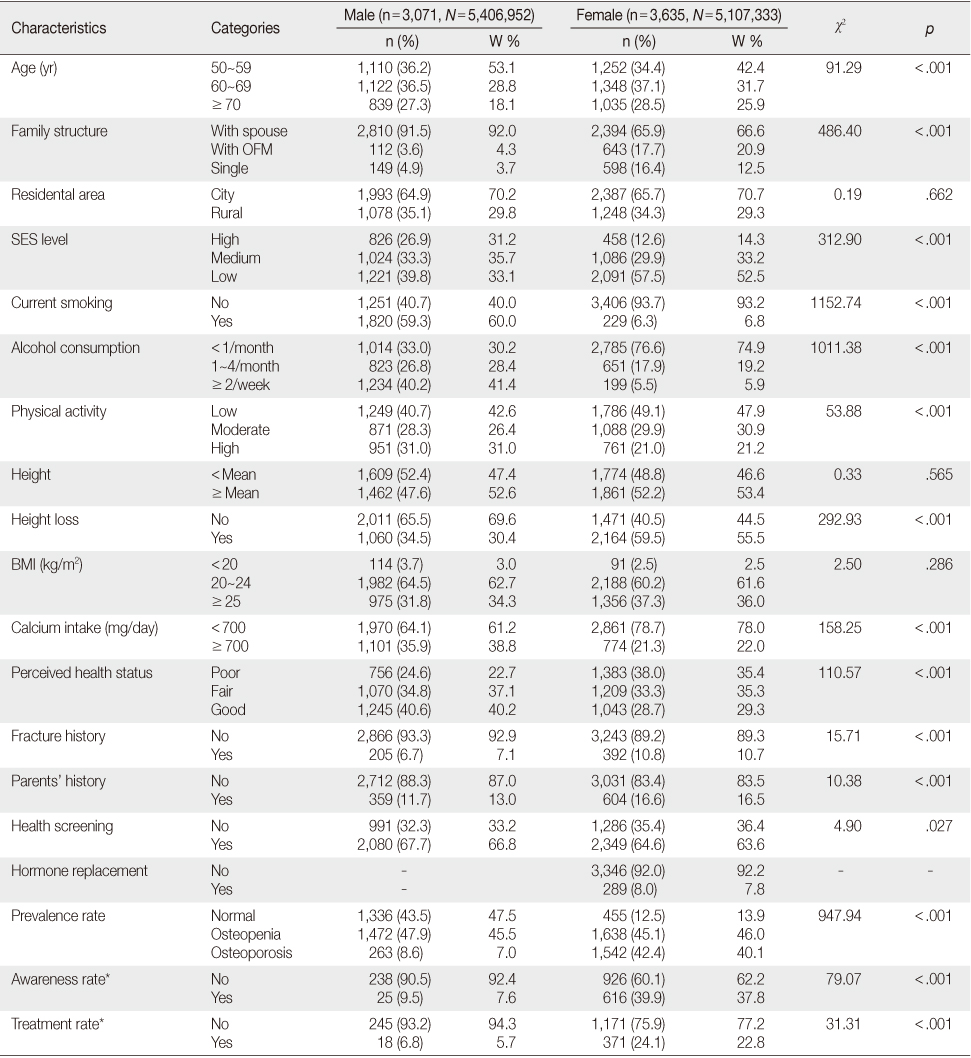
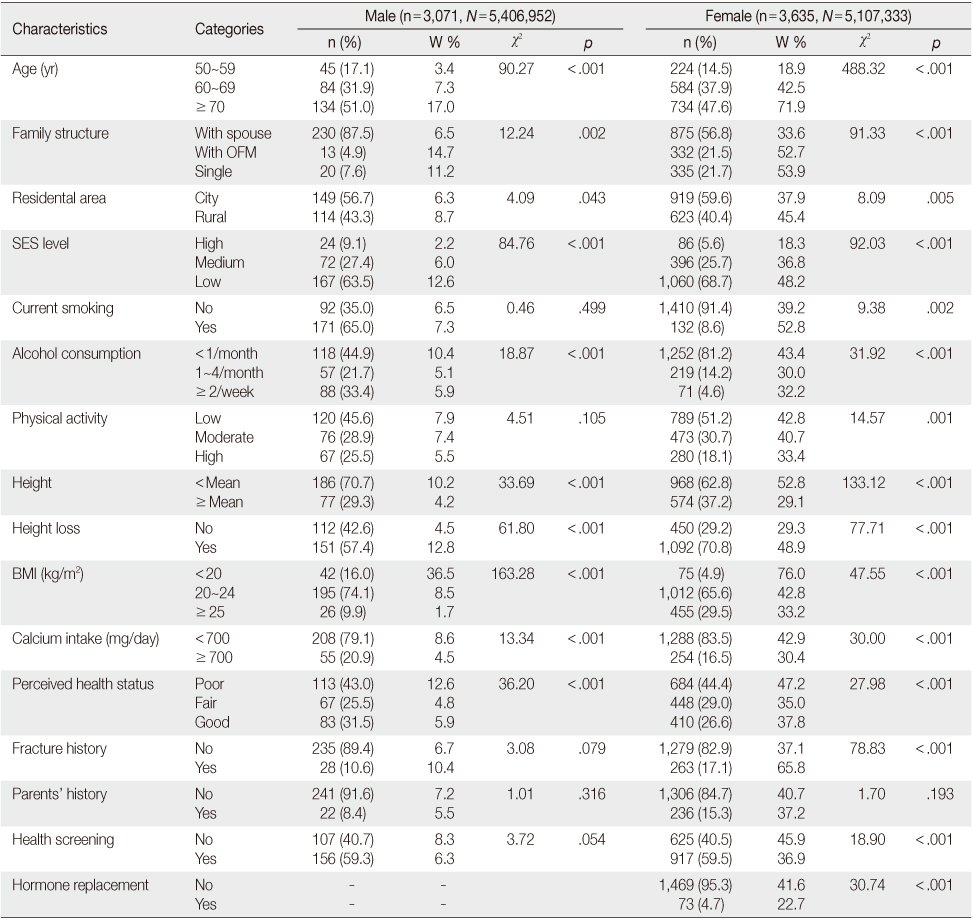
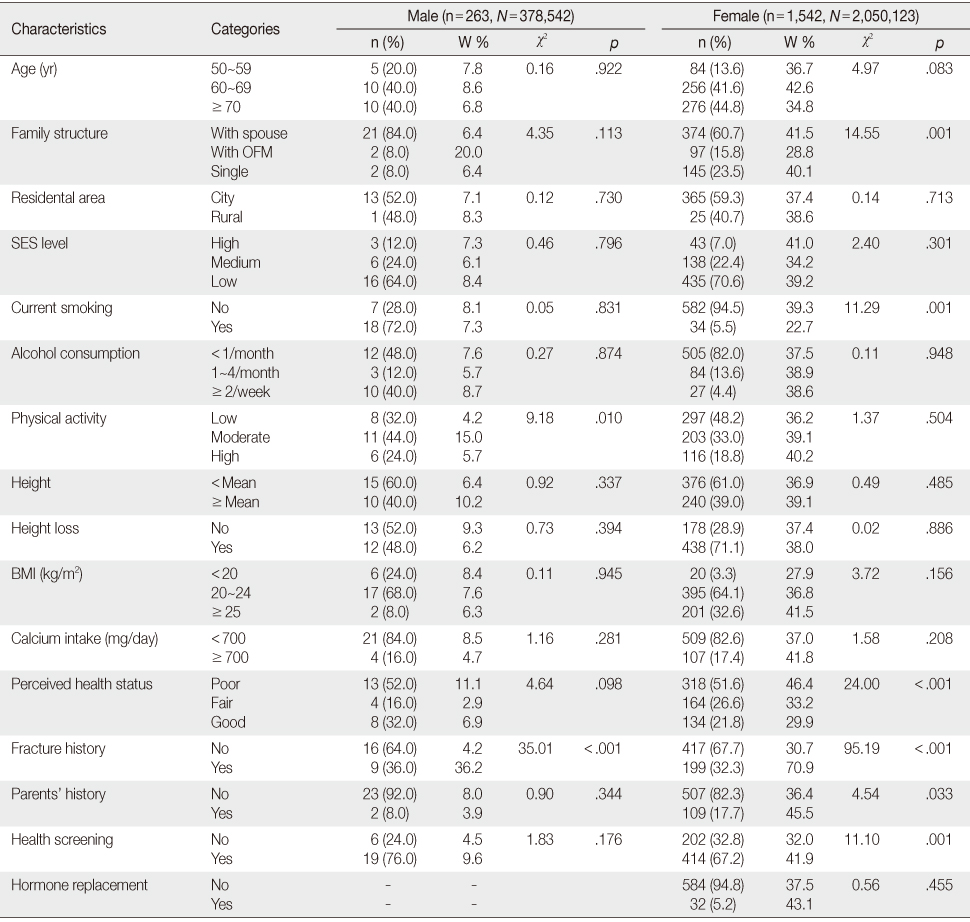
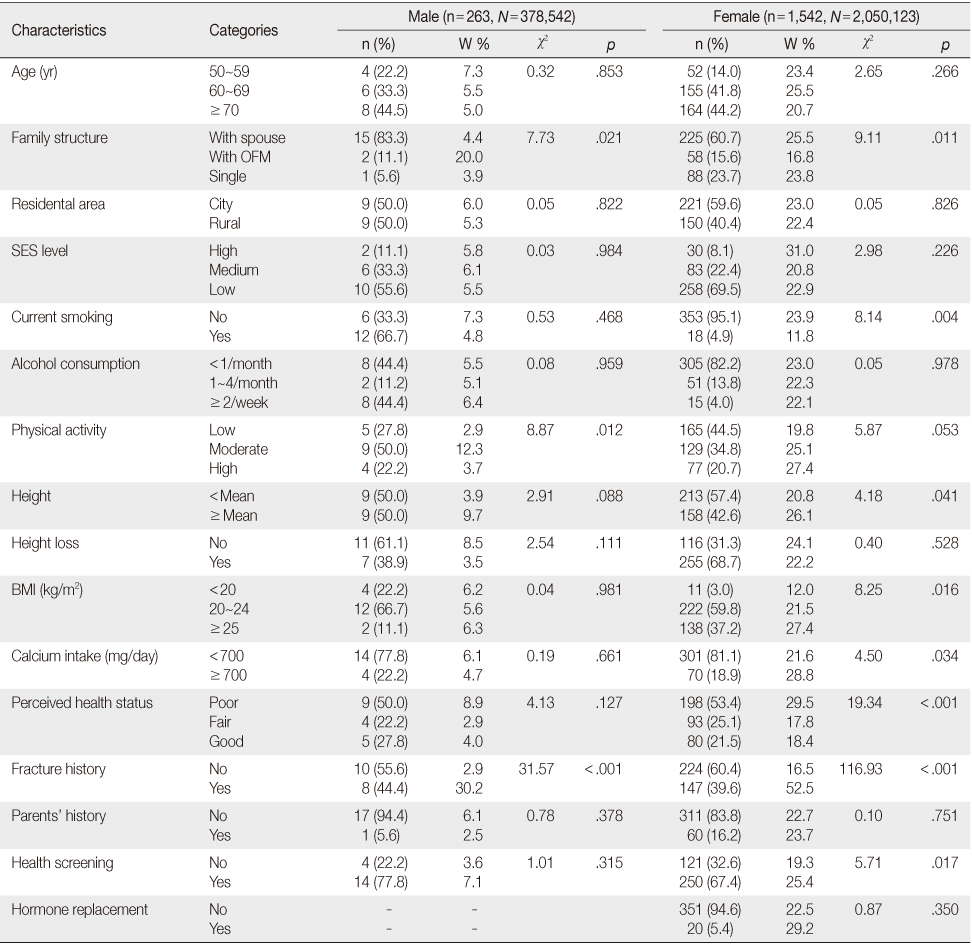
 Cite
Cite

